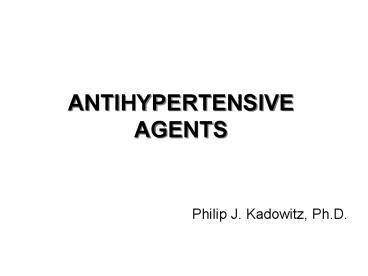ANTIHYPERTENSIVE AGENTS - PowerPoint PPT Presentation
1 / 15
Title:
ANTIHYPERTENSIVE AGENTS
Description:
Describe the impact and mechanisms involved in essential ... Drugs: hydralazine, diazoxide, sodium nitroprusside, minoxidil, enalapril, lisinopril, losartan ... – PowerPoint PPT presentation
Number of Views:794
Avg rating:3.0/5.0
Title: ANTIHYPERTENSIVE AGENTS
1
ANTIHYPERTENSIVE AGENTS
- Philip J. Kadowitz, Ph.D.
2
Learning Objectives
- Describe the impact and mechanisms involved in
essential hypertension. - Explain actions of major classes of
antihypertensive drugs. - Describe the use of drugs in the treatment of
essential hypertension and of a hypertensive
emergency or crisis. - Drugs hydralazine, diazoxide, sodium
nitroprusside, minoxidil, enalapril,
lisinopril, losartan
3
Drugs Used in the Treatment of Hypertension
- Diuretics
- a. Thiazide diuretics important for
antihypertensive therapy - ? do not exert their effect simply by
lowering plasma volume - ? plasma volume returns to pre-treatment
levels, but antihypertensive effect
persists - ? alter arteriolar tone
- b. Potassium-sparing diuretics spironolactone,
eplerenone, amiloride, triamterene. - c. Loop diuretics (e.g., furosemide) used for
edema reduction decrease plasma volume thereby
lowering pressure. Use with low GFR.
4
2. Centrally-acting antihypertensive agents
alpha-2 agonists
- Clonidine (Catapress) acts direclty on
alpha-2 receptors in vasomotor center - Methyldopa (Aldomet - metabolized in CNS to
?-methyl norepinephrine, which acts on
?2-receptors in vasomotor center - 3. Adrenergic receptor-blocking agents
- a. ?-blockers propranolol, metoprolol,
atenolol, etc., act on the heart to decrease
heart rate and stroke volume also more slowly
to reduce TPR - b. ? -blockers
- Prazosin (Minipress) blocks ? 1 receptors,
thereby permitting norepinephrine to act on ?
2 receptors and inhibit release - Non-selective ? -blockers rarely used, due
to reflex tachycardia (phentolamine)
5
4. Adrenergic terminal-blocking drugs
- Reserpine depletes adarenergic terminals
- Guanethidine reserpine-like and
bretylium-like effects of guanethidine deplete
adrenergic terminals of norepinephrine and
inhibit transmitter release, thereby reducing
sympathetic tone to vessels and heart - MAO inhibitors (e.g., tranylcypromine,
phenelzine, pargyline ) not used - 5. Direct vasodilators
- a. Arteriolar
- Hydralazine always used with ?-blocker due
to reflex tachycardia and with a diuretic - Diazoxide chemically related to thiazide
diuretics used in hypertensive crisis - Minoxidil used in hypertensive patients
refractory to other agents grows hair
6
b. Arteriolar and venous
- Nitroprusside (Nipride) - used only i.v. in
hypertensive crisis can titrate blood pressure
to desired level with infusion (rapid onset,
rapid termination of action) - 6. Calcium entry blockers
- L-type calcium channel blockers
- 7. Renin-angiotensin inhibitors
- a. ACE inhibitors
- ? peptidyl dipeptidase (converting enzyme)
inhibitors - ? inhibit formation of angiotensin II
(active) from angiotensin I (inactive) - ? inhibit breakdown of bradykinin
- ? effective orally
- ? cause coughing in up to 25 of patients
7
Captopril
- ? short-acting
- ? not a prodrug
- Enalapril
- ? prodrug long-acting
- b. Angiotensin receptor antagonists ARBS
effective orally, do not alter bradykinin
levels - Losartan
- Candesartan
- Valsartan
8
Major Drugs
- ? Diuretics
- ? Beta-blockers
- ? Calcium entry blockers
- ? ACE inhibitors
- ? ARBS
9
New approach to treatment of hypertension
- ? Allhat trial
- ? JNC 7 and 8
10
Figure 11-1. Anatomic sites of blood pressure
control.
11
Figure 11-2. Baroreceptor reflex arc.
12
Figure 11-3. Sites of action of the major
classes of antihypertensive drugs.
13
Figure 11-4. Guanethidine actions and drug
interactions involving the adrenergic neuron. (G,
guanethidine NE, norepinephrine TCA, tricyclic
antidepressants.)
14
Figure 11-6. Sites of action of ACE inhibitors
and angiotensin II receptor blockers. 1 Site of
ACE blockade. 2 Site of receptor blockade.
15
Figure 314. Summary of the three major effects
of angiotensin II and the mechanisms that mediate
them.































